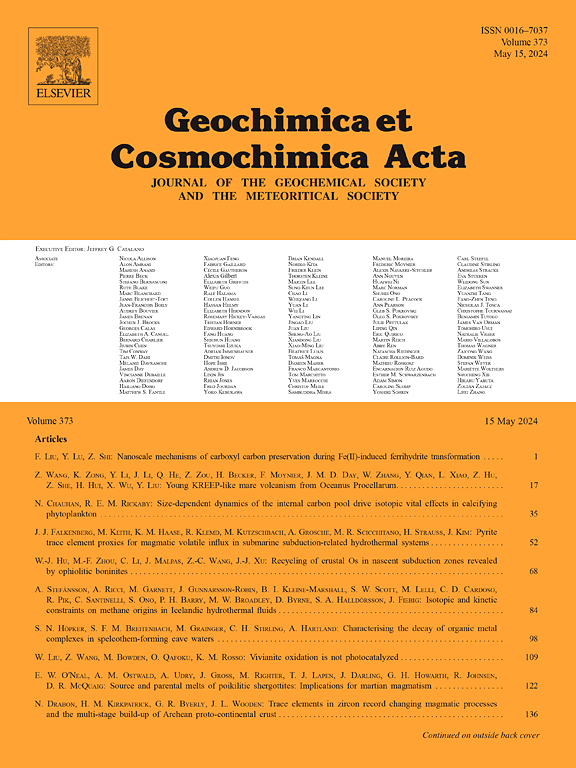The effect of carbonate chemistry on trace element incorporation in high-Mg calcitic foraminifera
IF 4.5
1区 地球科学
Q1 GEOCHEMISTRY & GEOPHYSICS
引用次数: 0
Abstract
The sodium-to-calcium ratio (Na/Ca) of biogenic CaCO3 has recently been introduced as a proxy for past seawater Ca2+ concentrations ([Ca2+sw]) as demonstrated by a positive correlation between seawater and shell Na/Ca with a minor influence of salinity. In the present study, we investigate the effect of carbonate chemistry on the Na/Ca proxy by conducting a set of experiments in which pH and the concentration of dissolved inorganic carbon (DIC) were independently varied. In addition to Na+, the incorporation of Li+, Mg2+, and Sr2+ into the shells of the large benthic high-Mg calcitic foraminifer Operculina ammonoides was assessed by culturing under constant DIC (∼2170 µmol kg−1) with varying pH (7.5–8.4 NBS scale), and under varying DIC (830–2470 µmol kg−1) with constant pH (∼7.9). Foraminiferal growth rate correlates linearly with calcite saturation state (Ω) of the experimental seawater (SW). The lowest pH and DIC experiments were characterized by low population growth rates, and some of these specimens died and their shells partially dissolved.
Na/Cashell and Li/Cashell in O. ammonoides are positively correlated with SW [CO32–] and Ω, whereas Sr/Cashell and Mg/Cashell are much less sensitive to these parameters. The relative sensitivity of Na/Cashell to Ω in O. ammonoides is ∼ 4 % per Ω unit. However, given that past changes in surface water Ω were probably small relative to changes in [Ca2+sw] the correction for this secondary effect over the Cenozoic is likely to be small. Therefore, we conclude that the sensitivity of O. ammonoides Na/Ca to the carbonate system is unlikely to compromise the use of this proxy to reconstruct past [Ca2+sw]. In the case of the low-Mg planktic and benthic foraminifera, a data compilation exercise indicates that no resolvable carbonate chemistry effect exists on Na/Ca. Thus, the Na/Ca proxy in benthic nummulitid and planktic foraminifera can be utilized for past [Ca2+sw] reconstructions. Furthermore, coupling this information with the distribution coefficients of other elemental and isotopic systems (e.g., Li+, Sr2+, Mg2+, K+, B, δ11B) may allow the reconstruction of wider aspects of past ocean chemistry. Finally, comparison of trace and minor element incorporation into low and high-Mg foraminiferal species, coccolithophores, inorganic calcite, and amorphous CaCO3 (ACC), we propose a modified biomineralization model for hyaline foraminifera centered on SW vacuolization. Foraminiferal data can be explained by a biomineralization process in which high-Mg species utilize a precursor phase (ACC) to produce high-Mg calcite whereas low-Mg species actively remove Mg2+ from the site of calcification.
碳酸盐化学对高mg钙质有孔虫微量元素掺入的影响
生物源CaCO3的钠钙比(Na/Ca)最近被引入作为过去海水Ca2+浓度([Ca2+sw])的代理,海水和贝壳Na/Ca之间呈正相关,盐度的影响很小。在本研究中,我们通过进行一组pH和溶解无机碳(DIC)浓度独立变化的实验来研究碳酸盐化学对Na/Ca代理的影响。除了Na+外,通过在恒定DIC(~ 2170µmol kg−1)和恒定pH (7.5-8.4 NBS尺度)下以及在恒定pH(~ 7.9)下变化DIC(830-2470µmol kg−1)的培养,研究了Li+、Mg2+和Sr2+在大型底栖高mg钙质有孔虫(Operculina ammonoides)壳中的掺入情况。有孔虫生长速率与实验海水(SW)方解石饱和状态(Ω)呈线性相关。低pH和低DIC实验的特点是种群生长率低,部分标本死亡,壳部分溶解。
本文章由计算机程序翻译,如有差异,请以英文原文为准。
求助全文
约1分钟内获得全文
求助全文
来源期刊

Geochimica et Cosmochimica Acta
地学-地球化学与地球物理
CiteScore
9.60
自引率
14.00%
发文量
437
审稿时长
6 months
期刊介绍:
Geochimica et Cosmochimica Acta publishes research papers in a wide range of subjects in terrestrial geochemistry, meteoritics, and planetary geochemistry. The scope of the journal includes:
1). Physical chemistry of gases, aqueous solutions, glasses, and crystalline solids
2). Igneous and metamorphic petrology
3). Chemical processes in the atmosphere, hydrosphere, biosphere, and lithosphere of the Earth
4). Organic geochemistry
5). Isotope geochemistry
6). Meteoritics and meteorite impacts
7). Lunar science; and
8). Planetary geochemistry.
 求助内容:
求助内容: 应助结果提醒方式:
应助结果提醒方式:


